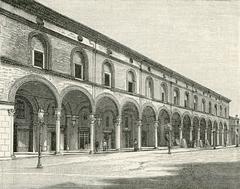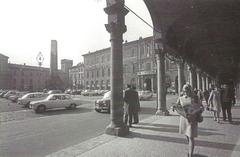Rocca Sforzesca Imola: Ultimate Guide to Visiting Hours, Tickets & History
Date: 04/07/2025
Introduction
The Rocca Sforzesca of Imola, a formidable symbol of Emilia-Romagna’s medieval and Renaissance past, stands at the crossroads of history and culture. Built in the 13th century and transformed by powerful dynasties like the Sforza and Riario, it served both as a defensive bastion and a noble residence. Today, visitors can explore its well-preserved towers, ramparts, and museum collections that bring Imola’s storied past to life. This guide provides a detailed overview of the fortress’s evolution, practical visitor information—including current restoration updates, tickets, and accessibility—and travel tips for an enriching visit (Rocca Sforzesca Imola: A Historical Fortress and Visitor’s Guide, Visiting Rocca Sforzesca Imola: Hours, Tickets, and Historical Guide).
Table of Contents
- History and Significance
- Architectural Features
- Artistic Heritage and Museum Collections
- Visiting Information
- Community Role and Cultural Events
- Preservation and Restoration
- FAQs
- Practical Tips and Contact Details
- References
History and Significance
Medieval Foundations
The origins of the Rocca Sforzesca date to 1261, built atop an earlier 11th-century tower at the edge of Imola’s medieval city. Initially conceived as a rectangular fort with ten square towers and a central keep (mastio), the fortress was a vital defensive stronghold. Over the 14th century, it changed hands among the Church, Alidosi, Visconti, and Manfredi families, each adapting its defenses to evolving warfare (Castellinelmondo).
Renaissance Transformations
The Sforza dynasty, rulers of Milan and major patrons of Renaissance art and science, took control in the late 15th century. Between 1472 and 1484, they undertook a major reconstruction, replacing the square towers with massive circular bastions to withstand cannon fire, and thickening the walls. The addition of a Renaissance-style residential wing (Palazzetto del Paradiso) reflected the dual military and domestic purpose of the Rocca (Atlas Obscura).
The Era of Caterina Sforza
Caterina Sforza, known as the “Tigress of Forlì,” became the fortress’s most legendary resident. Renowned for her courage and political savvy, she defended Imola and the Rocca through sieges and intrigue. Her defiant stand against her enemies, as recounted by Machiavelli, and her pursuit of alchemy and science, left a lasting imprint on the site (Travelemiliaromagna, Atlas Obscura).
Borgia Conquest & Papal Rule
In 1499, Cesare Borgia conquered Imola, ending Sforza-Riario rule. Leonardo da Vinci, in the service of Borgia, surveyed the Rocca’s defenses in 1502, leaving behind maps that underscore the fortress’s strategic value. With Imola’s annexation to the Papal States, the Rocca shifted to a state prison, a role it maintained until the mid-20th century (Castellinelmondo).
From Prison to Museum
Restoration began in 1958, transforming the Rocca into a museum and cultural venue. Today, it houses collections of medieval and Renaissance arms, ceramics, and artifacts, and serves as a venue for exhibitions and community events (Camping Imola).
Architectural Features
The Rocca Sforzesca exemplifies the evolution from medieval fortress to Renaissance stronghold. Its quadrangular plan is framed by four circular bastions, a deep moat (still visible on three sides), and a central keep. The blend of military and residential spaces, including the Palazzetto, reflects changing priorities from pure defense to comfort and prestige (Atlas Obscura, Camping Imola).
- Clock Tower (Torre dell’Orologio): Offers panoramic views and is a highlight for visitors.
- Battlements & Walkways: Allow exploration of defensive positions.
- Dungeons: Bear traces of their use as prisons, including historic graffiti.
- Museum Rooms: Display arms, armor, and ceramics discovered during restoration (Imola Faenza).
Artistic Heritage and Museum Collections
The Rocca’s interiors balance military austerity with Renaissance decoration. The Civic Museum features:
- Fresco Fragments: Depicting heraldic, religious, and courtly scenes.
- Weapons and Armor: Spanning from the Middle Ages to the Renaissance.
- Ceramic Collections: Particularly 16th-century wares found onsite.
- Temporary Exhibitions: Highlighting local history and art (Civic Museum Collections, Discover the Fortress Interior).
Visiting Information
Restoration Update (July 2025)
The Rocca Sforzesca is currently closed for restoration, with reopening expected by late 2025. Restoration is funded by the PNRR and the Comune di Imola, focusing on accessibility improvements, roof and masonry repairs, and conservation of historical features (Restoration Details, Colli Bologna).
Check official sources before planning your visit:
Typical Visiting Hours (when open)
- Friday: 15:00–19:00
- Saturday & Sunday: 10:00–13:00; 15:00–19:00
- Special Openings: Major holidays (see above)
- Closed: Mondays, December 25, January 1, and Easter (Visitare Imola)
Tickets and Discounts
- Standard Ticket: €4.00
- Reduced Ticket: €3.00 (check eligibility)
- Combined Tickets: 2 museums for €6.00; 3 museums for €8.00
- Free Admission: Children under 14, disabled visitors with companion, Imola residents (see official details)
- Card Cultura: Discounts for pass holders
Tickets are available at the entrance or can be reserved in advance by email or phone (Imola Musei).
Accessibility
- Wheelchair access: Available upon 24-hour advance reservation, in collaboration with Auser Imola.
- Contact: [email protected] | +39 0542 602609 (Bologna Welcome)
Guided Tours and Educational Activities
- Guided Tours: For groups and school classes, Tuesday–Friday by reservation.
- Audio and Video Guides: Available for self-guided visits.
- Workshops & Family Activities: Regularly scheduled, particularly on weekends and holidays.
Best Times to Visit
- Spring and Autumn: Pleasant weather and fewer crowds.
- Summer: More events but higher visitor numbers.
- Winter: Quieter experience; dress warmly for open-air sections.
Facilities and Visitor Services
- Restrooms: Onsite.
- Bookshop/Souvenirs: Available.
- Café: Small refreshment area.
- Photography: Permitted for personal use; check for restrictions.
- Event Spaces: Host to concerts, exhibitions, and festivals.
Combined Itineraries & Nearby Attractions
Enhance your visit with Imola’s other historical highlights:
- Palazzo Tozzoni: 18th-century noble residence.
- Chiesa di San Domenico: Renowned for art and architecture.
- Autodromo Enzo e Dino Ferrari: Famous racing circuit.
- Imola city center: Piazza Matteotti, local markets, and shops.
Combined tickets are available for multiple museums (Bologna Welcome).
Community Role and Cultural Events
The Rocca Sforzesca is a cultural anchor for Imola. It hosts art exhibitions, historical reenactments, open-air concerts, and community festivals such as “Imola in Musica” and the autumn Bacchanal. These events foster civic pride and attract visitors from across Italy (Local Festivals).
Preservation and Restoration
A major restoration (2024–2026) is conserving the fortress while enhancing accessibility and visitor experience, ensuring the Rocca remains a living monument for future generations (Restoration Details).
Frequently Asked Questions (FAQ)
Q: Is the Rocca Sforzesca currently open?
A: As of July 2025, the fortress is closed for restoration, with reopening expected late 2025.
Q: How do I buy tickets?
A: Tickets are available onsite or via advance reservation (email/phone).
Q: Is accessibility available?
A: Yes, with 24-hour advance notice for visitors with disabilities.
Q: Are guided tours offered?
A: Yes, for groups and schools by reservation; audio guides for individuals.
Q: What other sites can I visit nearby?
A: Palazzo Tozzoni, Chiesa di San Domenico, Imola’s city center, and the Autodromo.
Practical Tips and Contact Details
-
Address: Piazzale Giovanni Dalle Bande Nere, 40026 Imola, Italy
-
Phone: +39 0542 602609
-
Email: [email protected]
-
Official Website: Imola Museums – Rocca Sforzesca
-
Tourist Office: Via Emilia, 135 – 40026 Imola (BO), +39 0542 602207
-
Advance Booking: Strongly recommended, especially for accessible visits and group tours.
-
Footwear: Wear comfortable shoes for stairs and uneven surfaces.
-
Language: Italian signage is standard; English materials and tours often available.
-
Check websites for updates: Always confirm opening status before traveling.
References and Further Reading
- Rocca Sforzesca Imola: A Historical Fortress and Visitor’s Guide (Travelemiliaromagna)
- Visiting Rocca Sforzesca Imola: Hours, Tickets, and Historical Guide (Turismo Imolese)
- Rocca Sforzesca in Imola: Visiting Hours, Tickets, and Historical Insights (Bologna Welcome)
- Rocca Sforzesca Imola Visiting Hours, Tickets & Visitor Guide (Imola Musei)
Final Tips
The Rocca Sforzesca is more than a fortress; it’s a living chronicle of Imola’s resilience, innovation, and civic pride. With its ongoing restoration, the site is poised to offer enhanced accessibility, engaging exhibitions, and immersive experiences for all. Stay updated through official channels, plan ahead for guided tours and accessible visits, and explore the broader tapestry of Imola’s historical and cultural landmarks for a truly memorable journey.


